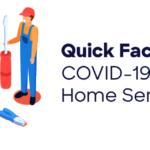
Running a home services business can be overwhelming to start – and from there it might feel like an endless game of catchup. In the process, you’re bound to make a few mistakes. But if you’re proactive, you might be able to avoid them altogether.
Here’s a look at nine of the most common mistakes home service professionals make – and how you can dodge them.
#9 Hesitating to Embrace Technology
Many professionals have a hard time transitioning from manual processes to digital ones. But technology is useful in both the office and the field. Business management software simplifies processes like estimating, billing and scheduling. Smart phones make it easy to send clients photos and videos. And home service technologies, like virtual reality tools, drones and robots, make for more accurate estimates, improved customer experiences and even reduced physical strain on employees.
#8 Not Developing Conflict Resolution Skills
When it comes to conflict and miscommunication, no one starts out knowing how to handle every possible scenario. If communication is a weakness for you, don’t ignore it. The best defense strategy is to communicate all of the project details and job requirements from the start, and to get everything in writing. Strengthen your conflict resolution skills and research resolution strategies and practice them should conflict arise – or consider hiring a specialist to advise you and your staff. If you’re not sure of the value, consider that, according to research from The Center for Construction Research and Training, The Cost of Interpersonal Conflict in Construction, professionals count conflict as a top factor in total project cost.
#7 Operating Without a Sales Pipeline
It’s tempting to take leads as they come, do your best work and move on. But for many businesses, this leads to a stagnant or unpredictable job flow. Take control with a well-developed sales pipeline. Enhance and update the platforms where clients find and research you, like your HomeAdvisor profile; have a distinct process for reconnecting with leads that fall off; and once you have a client, add them to your database and your email list — and continue to nurture the relationship after the project is complete.
#6 Sidelining Safety Procedures
Even though you have your employees’ best interests at heart, you still may not be doing enough to keep them safe. The construction industry ranks number one in work-related deaths, according to recent data from the Occupational Safety and Health Administration (OSHA). The best way to minimize risk is to hold regular safety trainings, communicate thoroughly with all individuals working on your jobsite, and implement all necessary safety precautions.
#5 Giving Marketing the Least Commitment
With everything else on your plate, marketing may not seem like the most important investment. However, skimping on your marketing strategy can cost you in the long-run. The very first building block of a good marketing plan is identifying your target client. From there, enhance your presence on the platforms they’re using, focusing on things like your HomeAdvisor profile, website and social media channels.
#4 Letting Your Online Reputation Manage Itself
When you get a review, whether it’s positive or negative, you may wonder what your next steps should be. In both situations, your next step is to respond! Consumers are looking for as much information as they can get when they’re researching. When they see you’re actively responding to reviews, it shows that you’re engaged. In fact, according to a 2018 BrightLocal survey, 89 percent of consumers look at responses to reviews!
Here’s a tip: For negative reviews, be courteous and understanding – and suggest that the reviewer contact you directly. That way, you can resolve the issue privately.
#3 Taking Too Much Work
Getting lots of leads can seem like a dream, and you might think you can handle it all. But overbooking can affect the quality of work, send schedules into overtime and reduce customer satisfaction. If you have an informed understanding of your work capacity, you’ll be better able to manage this quality vs. quantity problem. Assess the work you can accomplish with the team you have, and always move forward with that in mind.
#2 Not Prioritizing Recruiting and Retention
According to HomeAdvisor’s 2018 Skilled Labor Shortage Report, 63 percent of professionals couldn’t hire as many workers as they’d planned because they couldn’t find the talent. As a result, many professionals make the mistake of hiring the wrong people. Putting energy into finding the right employees will help to ensure that you’re hiring quality people who will be likely to stick around.
Look for individuals with passion, a good work ethic and a willingness to learn, and consider implementing an apprenticeship program. Once you have your team, value them, their time and their integrity – as you’d want them to value yours. Their wellbeing and satisfaction will translate into their work, and customers will notice.
#1 Running With Rough Estimates
Across the board, this is one of the worst mistakes professionals make. Overestimating can keep you from winning jobs and underestimating can keep you from making profit. This applies to estimates of project costs as well as project timelines.
When you put an estimate or timeline in writing, it should cover the realities of the task at hand. Your project cost should cover materials, labor, overhead and profit. Your timeline should account for permits, shipments, subcontractor schedules and potential weather. When you factor for all of these things, you’ll have better outcomes both financially and with customer satisfaction.
Stay Up to Date on Trends
Get the latest marketing & business tips in your inbox.










